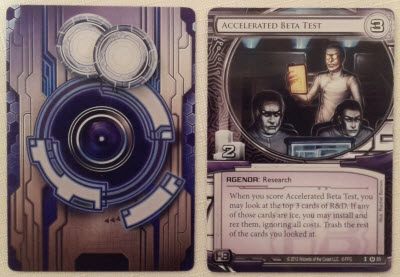The rush of adrenaline fired her synapses as data flowed past her display. Six months of hard work had led to this moment, six months spent crunching mind numbing strings of code and shopping for rigs on grey markets half as likely to mug her as sell her anything worth her cred. Six months of sleepless nights and dead compilers, six months of skipping meals to afford the right Icebreakers and the extra bit of RAM when she needed it. It was the moment of truth for her, and right now, it was not about the money. Jinteki could buy and sell a thousand women like her, and did every day. It was not about the glory, even if the thought of being the thorn in the shoe of the giant brought a smile to her face. It was not about the secrets the corps kept like a dozen swinging swords of Damocles, ready to drop on everyone’s heads.
Two years ago her mother, a faithful Jinteki worker, logged into the wrong server at the wrong time. The wrong bit of code flashed through her AR broadcast, blinding her eyes and reducing her mind to a jumbled mix of half-words and fear. And they simply wrote her off.
Today was not about money, or glory, or secrets. Today was about revenge, about making a giant bleed from a thousand cuts. And she had the best razor blades programs around, warm in her rig and ready to rip.
The Premise
The world may have evolved, but humanity’s troubles haven’t. In this dystopian world of high technology and high stakes ambition, two players square off against one another in a battle of cyber warfare. One player represents a futuristic megacorporation looking to further their goals, while the other is an a enigmatic hacker determined to stop them.
The Rules
Android: Netrunner is a two-player asynchronous card game, where one person plays as the Corporation and one portrays hackers known as Runners.
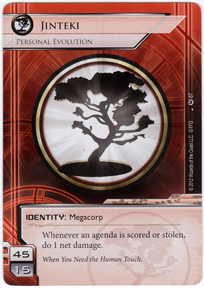
Reach out and clone someone.
In contrast to CCG games, Android: Netrunner can be played out of the box. While the game can be heavily customized – the full rule book goes into detail on that – it contains four Corporations (Jinteki, Haas-Bioroid, Weyland, and NBN) and three Runners (Shaper, Anarch, and Criminal) that players choose from. Each faction contains varying themes and abilities.
There is almost no setup in Netrunner; players begin by mixing all cards of their faction with their side’s faction-neutral cards to form decks. Players also start with five credit tokens – the game’s currency. Each player starts with a hand of five cards.
The Corp player begins by drawing a card. They then may take three actions, including drawing cards, playing cards, or gaining credits. Their starting territory consists of three areas, called Servers. These Servers are the player’s hand, deck, and discard pile. Additional Server columns can be also created.
Corporate cards consist of Operations, Assets, Agendas, Upgrades, and Ice. Operations are single-use cards. The remaining four types are placed face-down in play. Assets and Agendas are put at the base of a new Server, while Upgrades go below them. Assets provide the Corp with a variety of powerful tools, and Agendas are used to score VP.
The Corporate player gets points by revealing an Agenda and scoring VP for its value. To protect Asset and Agendas from the Runner, the Corporate player installs software cards called Ice. Ice come in a variety of subtypes and strengths.
After the Corp player takes their actions, it’s the Runner’s turn. The Runner’s imperative is to steal an Agenda card before it gets scored, and they can be taken from any Server. Runners begin with four actions and their choices also include using them to draw cards, put cards in play, or get credits.
The Runner’s play area is known as their Rig. Three of the four Runner card types make up the Rig: Resources, Hardware, and Programs. (The fourth, Events, are just like Operations as one time use cards). Resources provide the player with income and extra abilities, and Hardware improves a Runner’s gear. The most important cards to a Runner, though, are Programs: they are the weapons used against the Corporate player’s Servers.
Assaulting a Server is known as making a Run. For each piece of Ice the Runner encounters, they must defeat it, stop the Run, or suffer the Ice’s consequences. Such consequences can range anywhere from losing actions to taking damage. Damage is the most dangerous, as it forces the Runner to discard cards. If the Runner reaches the Server, the Server card and/or any Upgrades are revealed. The Runner may pay to discard revealed Upgrades or Assets, but if it is an Agenda, the Runner scores it for themselves.
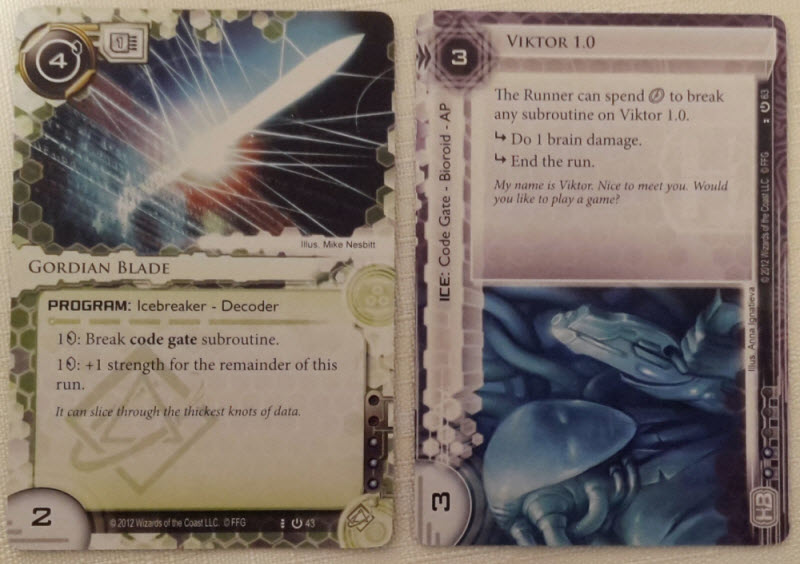
The code gate Icebreaker must pay 1 credit to face Viktor, and then must at least break its second effect to pass.
The Corporation wins by scoring seven Agenda points or if the Runner takes more damage than cards in their hand. The Runner wins if they can successfully steal seven Agenda points, or if the Corporation has to draw from an empty deck.
At that point, it would seem logical that one side has clearly defeated the other, and that would be the end of it. But a single game of Android: Netrunner is just one battle in a much larger war…
You’re Speaking My Language
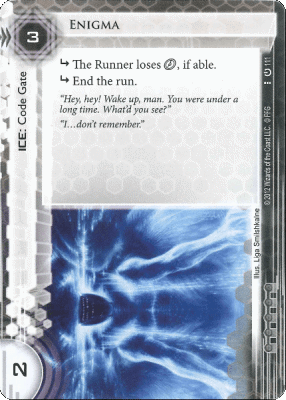
With all the terms, Enigma may also be your comprehension.
Pick any game off a shelf, and it’s very likely to introduce some new rule, mechanic, or thematic concept that makes it unique. Exploring new gaming ideas and possibilities is part of what makes gaming fun. However, once past a certain threshold (which varies by individual), people can instead be turned away from new ventures. There comes a point where the effort to learning something new isn’t worth the potential entertainment value it offers.
Consider teaching someone to drive a car. Most are willing to learn on an automatic transmission, but the number drops a bit if you say you’re using a manual instead. Then there will be an even steeper decline if you said you’re actually going to start off by learning to drive a semi truck. The more new information that gets thrown at you at once, the more likely it is to temper enthusiasm.
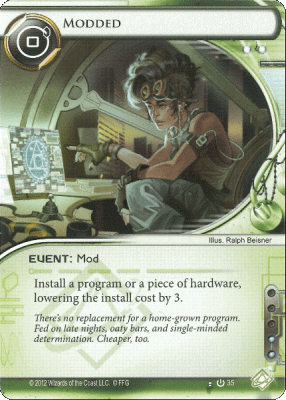
Time to gear up.
The same can happen with Android: Netrunner. The game has a very evocative theme, quickly pulling you in to an ongoing struggle between monolithic companies and the renegades of society who oppose them. Every facet corresponds to some aspect of this struggle, be it in the game’s wonderful artwork or how the game plays out mechanically.
It also uses a lot of jargon and slang. A player’s hand isn’t just their hand, it is their HQ or their Grip. You don’t just flip a piece of Ice over, you rezz it. When a Corporation attempts to track the Runner down, they initiate a Trace, which is potentially countered by the Runner’s Links. And so on.
On the one hand, this is icing on the cake to the game’s flavor, maintaining its identity no matter which cards are used, and it appeals to Immersionists in ways that many card games don’t. On the other hand, all of the jargon and rules involved can be overwhelming to some. (Socializers needn’t bother with this foray into cyberspace.) Similar to games that rely heavily on symbols to explain what you’re doing, there is a lot of translation that goes on here. While Netrunner is actually pretty straightforward compared to many other customizable card games, its robust theme can ironically add unexpected complexity.
When Opposites Attract
Netrunner’s most unique aspect is that it’s entirely based around asynchronous play. You aren’t forced into simply choosing a separate fantasy race or magical element to battle with. Rather, Netrunner has two fundamentally different decks, each with their own card types, rules, play areas, and win conditions.
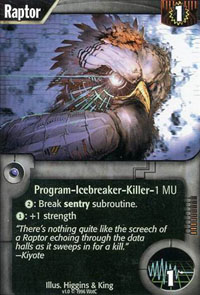
An original Icebreaker.
The fact that these decks interlock so well is a testament to the game’s design. The original Netrunner was created in 1996 by Richard Garfield, the same mind behind Magic: the Gathering – a monolith in its own right within the card game genre. Indeed, even back then the game’s mechanics were lauded as fantastic and innovative, and while it didn’t have the same success as its current incarnation, much of the game retains the same architecture.
What has changed is that each side now has more options to defeat their opponent, through customization. Each faction is designed to focus primarily on its own cards, but you are able to include small aspects of other factions to suit your needs. A Jinteki deck can borrow a few NBN cards to draw faster, or a Shaper deck could use some Criminal cards to generate extra credit.
Customizing is hardly a requirement to enjoy Netrunner by any means, but the more comfortable you become, the more you’ll be tempted to swap out cards. Should you do so, you’ll find that each side is able to tailor their deck in a myriad of ways to suit your personal style.
Navigating Without A Map

Defeating three Ice could still backfire.
The principle criticism with Netrunner is its inherent unpredictability. Like many LCG and CCG games, there is a fair amount of luck and randomness to it. Games of Netrunner can be over in ten minutes, or they can last an hour. There are a number of reasons for this, but it generally boils down to two factors.
First is the style of the players. Android can be a cerebral game of deception and misdirection, where players must outwit one another as each side works to achieve their goals. Tacticians will enjoy Netrunner’s ample opportunitie for well-laid plans to come to fruition – especially as a Corp player.
However, Android can also be a game of overt aggression, offering a competitive play that befits ruthless and/or amoral factions. Both Runner and Corp are capable of this with equal aplomb (and that will make Strikers quite happy).
Architects illustrate this dichotomy not just for themselves, but for many players in general. For them, there’s a definite appeal to building out your Rig / Servers and working towards something, but they’ll prefer to play more casually to keep their interest. A more aggressive foe will turn them off of the game in short order. Indeed, a key factor to enjoying Netrunner is finding a player base that suits your intentions.
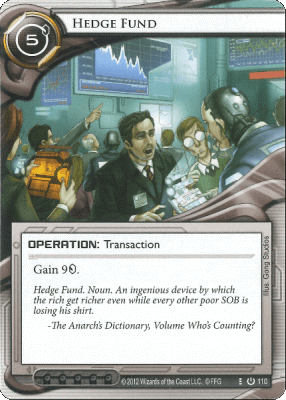
Like a real hedge fund, it’s only useful if you have the cash.
Second is the issue of resources. Like any card game, there’s no guarantee you are going to draw what you need to defeat your opponent in Netrunner. Games can become one-sided due to bad luck. The Corporate player could not draw enough Ice to protect itself, or the Runner may not get the necessary Programs to defeat powerful Ice abilities. And while both sides usually need more credits to fund their exploits, there’s no guarantee of steady income.
There’s also the notion of keeping your opponent guessing. Catering to the style Daredevils thoroughly enjoy, Netrunner has many opportunities for unorthodox tactics, unexpected card uses, and surefire gambles. In fact, gambles are often a requirement in this game of hackers and cybercrime, leading to many high risk, high reward situations. For many, though, the degree of randomness is a very real barrier to entry.
The Takeaway
Android: Netrunner is set in a futuristic landscape where rules are arbitrary and both sides have something to lose. Players determine the victor in a way that is part game and part dance. Because of its array of gameplay terms and moderate amount of luck involved, it isn’t a game that everyone will easily log on for. Nevertheless, Android: Netrunner is a prime example of a card game that blends theme and mechanics together in a way that doesn’t feel forced or surface-laden, and for that alone it deserves some praise. To do so where each side plays by different rules is all the more impressive.
Netrunner is a game that can be played casually out of the box or honed for nail-biting tit for tat moments. For a card game set in cyberspace, though, Netrunner shows itself to have a lot of heart. Granted, it may be a cloned heart, or an artificial one. Or maybe one bought from Bernie over on Newmarket Street. But a heart nonetheless.
Android: Netrunner is a product of Fantasy Flight Games.
Cardboard Republic Snapshot Scoring (Based on scale of 5):
Artwork: 4.5
Rules Clarity: 4
Replay Value: 4.5
Physical Quality: 4
Overall Score: 4.5
Photo Credits: Original Netrunner card by Netrunner Online.

